In the Bible, there are countless mentions of lambs both literal and metaphorical, a couple instances each of rabbits and eggs, and precisely zero references to coconuts. Nevertheless, Easter isn’t complete with a bag or two of that sweet, dusty, shredded coconut.
The coconut has historically been a domesticated food staple for many cultures around the globe, including Southeast Asian communities as well as diverse populations of Pacific Islanders. Shredded, or desiccated for my non-American readers, coconut was invented by several white men in the 1800s. I say “several” because several men claimed the title. There was Connecticut-based inventor E. Chapman Maltby who had been cleaning coconut shells for another project and then decided to shred the coconut meat for kicks. In 1876, Maltby and his partner Edward Smith debuted a coconut shredding machine at the Philadelphia Centennial Exposition. A few years later, a New York man named Leopold Schepp entered the shredded coconut game and earned the name the Coconut King of New York (so inventive!). And then there was the already aptly named Franklin Baker, the founder of of the retail brand Baker’s that is still known to this day for it’s baking chocolate, cocoa powder, and, of course, shredded coconut.
Baker realized the potential of direct-to-consumer recipes and published a little booklet in 1922, which included an introduction to coconut as a “wholesome body-building food” arguing that “pound for pound it is far more nourishing than beef and other standard foods. According to government reports, one pound of dried coconut equals two and one-half pounds of beef.” (I wonder if the raw milk and beef tallow folks know about this?) The booklet also described the two different Baker coconut products: the blue can with “fresh, ripe coconut, canned in its own milk,” and the yellow can “fresh, naturally moist coconut without the milk, sweetened with pure cane sugar.” This shredded, sweetened option was incredibly popular in the Southern United States and the phrase “Southern Style” was soon added to the marketing materials for yellow cans of Bakers coconut.
The South’s love of coconut cake, albeit not in springtime animal form, is largely credited to the work of Black Southern bakers. Often considered to be one of the first published coconut cake recipes, Malinda Russell includes a recipe for Cocoanut Sponge Cake (which calls for an entire coconut) in her 1866 text A Domestic Cookbook. A recipe for Mountain Cake—featuring a fluffy coconut exterior—is listed in Minnie Fox’s 1904 cookbook The Bluegrass Cookbook. White women included recipes for coconut cake in their cookbooks, too, likely inspired by cakes they had learned about from Black bakers. Marion Tyree includes multiple coconut cake recipes in her 1878 text Housekeeping in old Virginia. Eventually, much like other dishes and techniques born of enslaved and free Black culinary ingenuity, the coconut cake evolved into a generalized southern tradition.
How we got from southern staple to Easter centerpiece, I’m still not sure. Shredded coconut is a decorating medium that contains multitudes, which is why it has been used to denote everything from fluffy white snow to foaming waves on a tropical beach (which I now realize are both just different physical states of water, but you get my point). By the early 20th century, coconut was no longer novel and not particularly expensive, not necessarily a splurge for a fancy Easter Sunday supper. It certainly didn’t allude to any foods or symbols mentioned in Bible stories or even the pagan traditions on which Easter is based. Now surveying the southern Easter table, I’m also side-eyeing the traditional glazed ham. Why are you HERE, ham?! To which fable do you allude?!
Nevertheless, coconut dominated the midcentury Easter scene, covering everything: traditional layer cakes topped with jelly beans, traditional two-piece cake pan molded lamb cakes, daisies, and whatever this monstrosity is hatching out of the coconut-covered egg blow.

In 1958, Baker’s issued another branded baking booklet featuring all sorts of Cut-Up Cakes decorated with shredded coconut and other Baker’s products. One recipe was the Cut-Up Bunny Cake, a flat-lay cake made with two round layers cut into shapes to make a head and ears. The Women’s Pages went rabid for this cake and papers across the nation reproduced this story like, well, rabbits. According to several newspaper stories in the early 1990s, these little branded baking pamphlets were so popular that “over 3.5 million copies of the recipes were distributed across the United States” through mail-in and grocery store promotions.
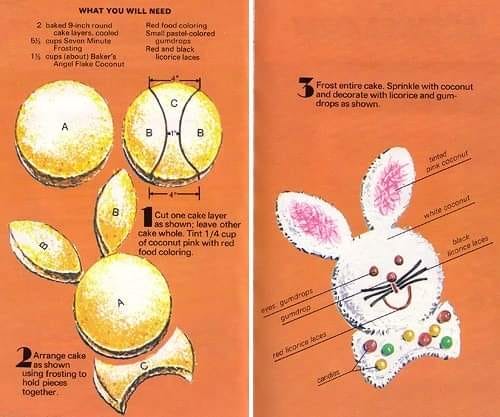
Baker’s did not, in fact, invent putting shredded coconut on cakes, they merely took advantage of a decorating trend that consumers were already doing. The 1952 Easter issue of the Chicago Sunday Tribune featured recipes for both lamb and bunny cakes made with traditional two-part cake molds. The recipe instructed readers to frost their bunnies with a seven-minute frosting and sprinkle with “shredded moist coconut.” The 1957 Easter issue of the Women’s Pages in Baltimore’s The Evening Sun provided multiple images (a generous give in those newspaper days) for constructing a Modern Bunny Cake without a dedicated mold. This “bunny sculpture” cake called for a loaf pan (much like Bayou Saint Cake’s modern loaf pan lamb cake!), with additional instructions for how to cut the cake just-so to make a body, legs, face, and tall ears. The resulting cake is covered in a marshmallow frosting and shredded coconut.
I asked my grandmother, who has made a Cut-Up Bunny Cake for Easter from time immemorial, why she bakes this cake and why she thought coconut has this association with Easter. Here is her response via text message:
Because they're so cute and of course the bunny is associated with Easter. I forgot to tell you that I tinted a little of coconut light pink for inside or middle of ears. Looks cute. Actually, you could toast coconut and make him brownish all over. I guess coconut at Easter is spring like and refreshing. Luv u.
So there you have it, we use coconut because it’s springlike, refreshing, and cute. Here are some of my favorite examples of just how cute (read: increasingly unhinged) coconut can be.
Happy Easter to all who celebrate!
BONUS CAKE: Devil’s Food Lamb Cake made with chocolate flavored shredded coconut
In the sequel to the Easter-timed horror film, this is the other baddie the original villain has to fight after which we realize ala Godzilla vs. Mothra that Coconut Egg Demon was really a friend to humans after all.






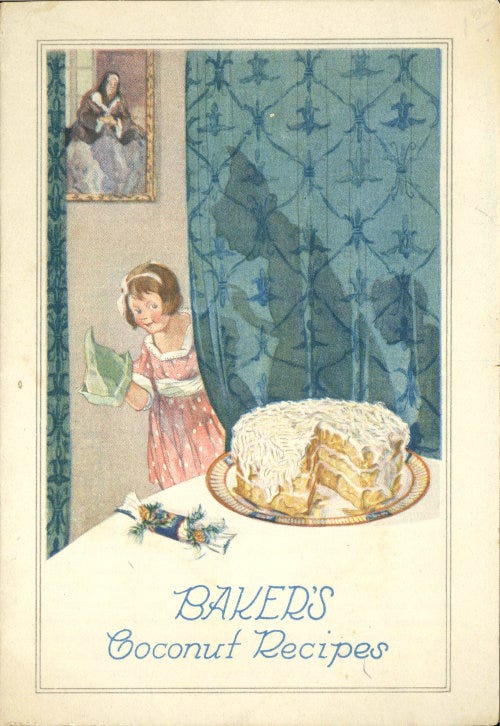
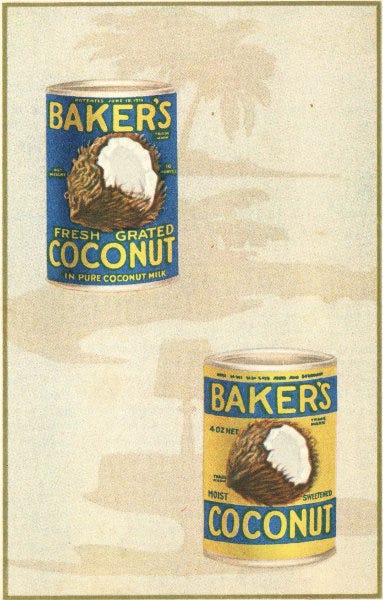


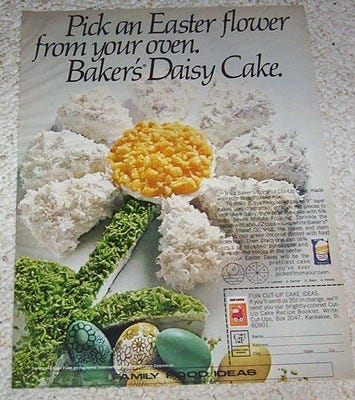



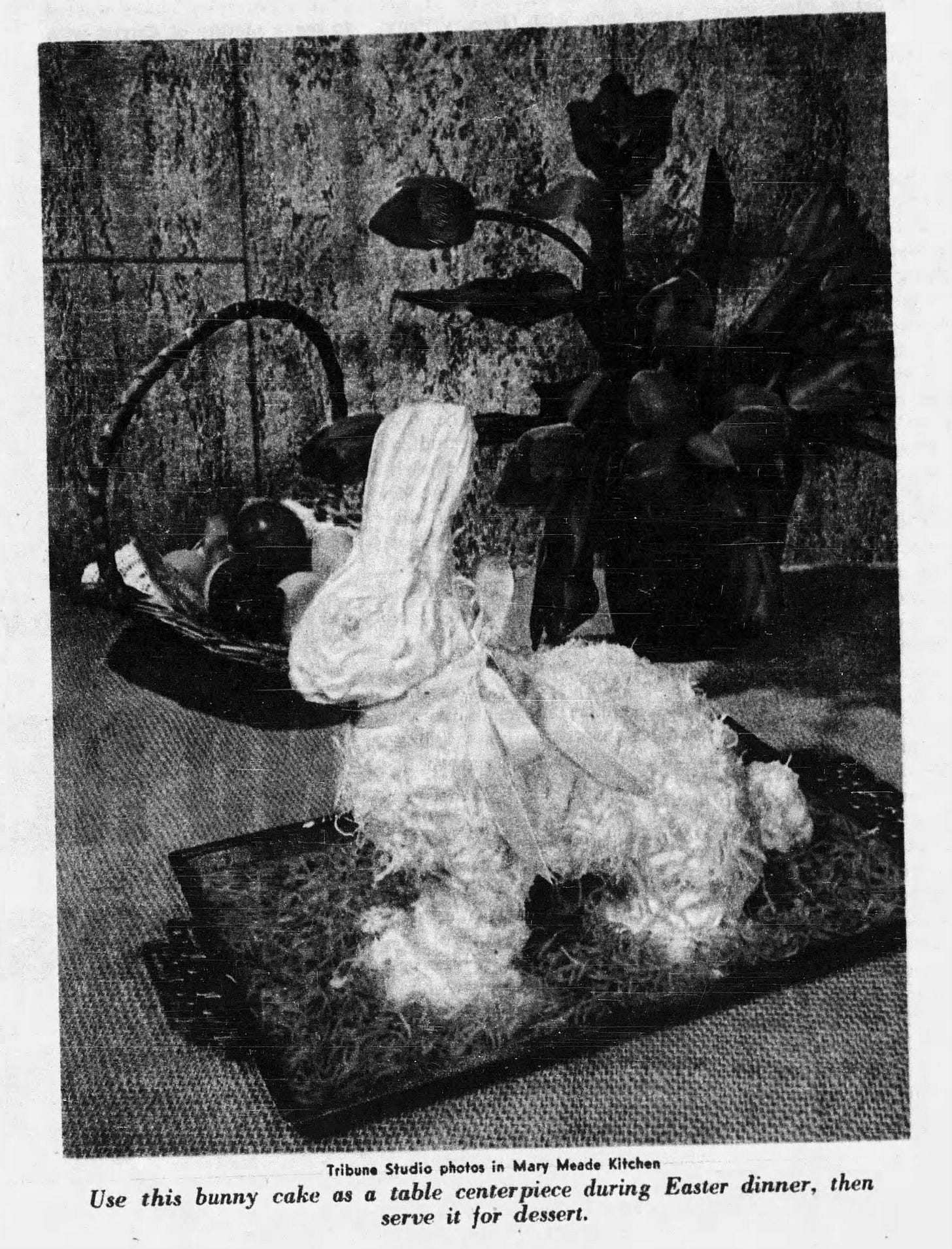



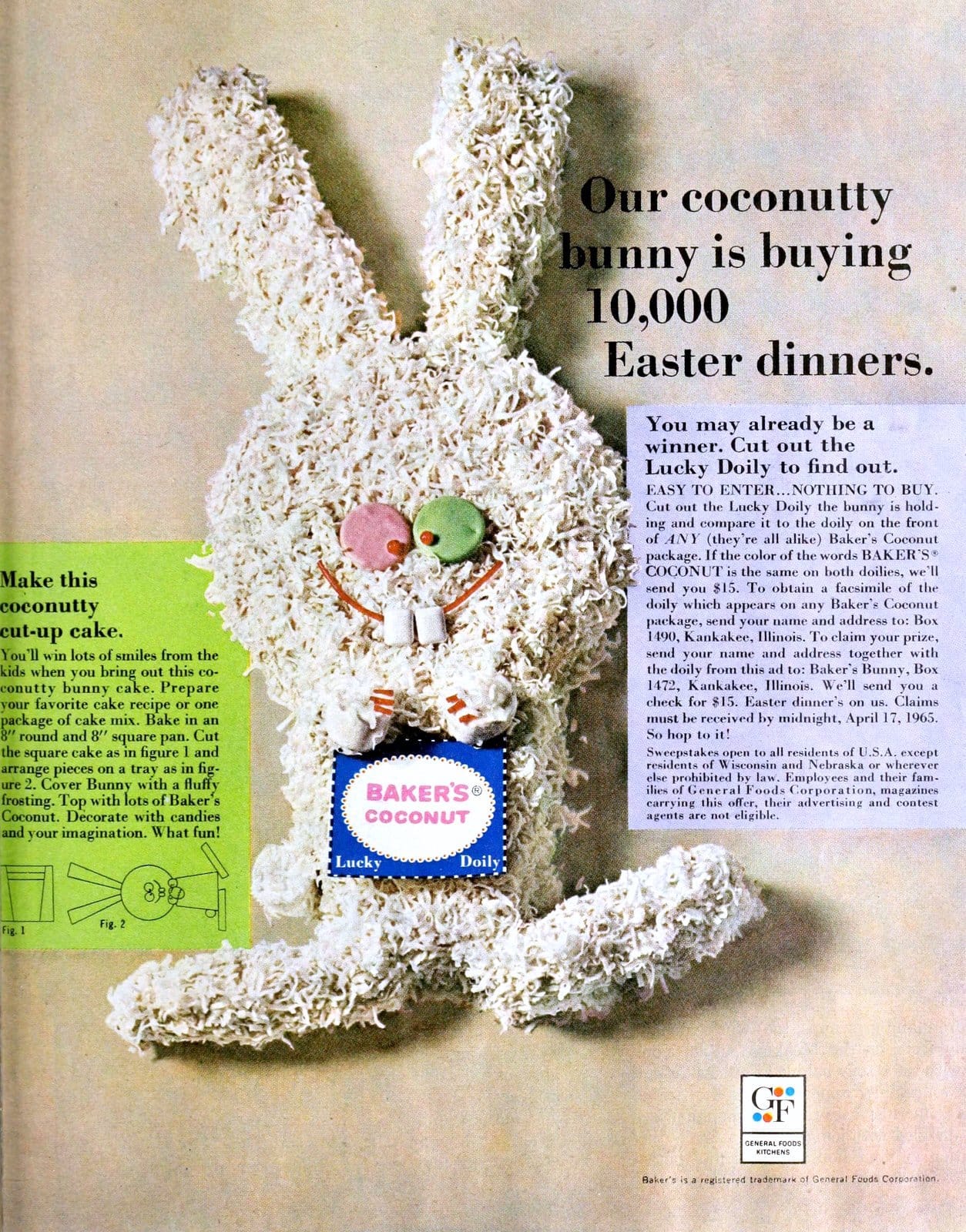


No, but who thought that little black lamb cake could look anything BUT demonic in a black-and-white newspaper photo, hahahaha. Somehow getting "wouldst thou like to live deliciously" + Scooby-Doo villain vibes??? When you said the examples you found were "increasingly unhinged" I was not prepared.
I’m doing it. I don’t know if it’s going to be a lamb or a bunny, but something shredded coconut this way comes…